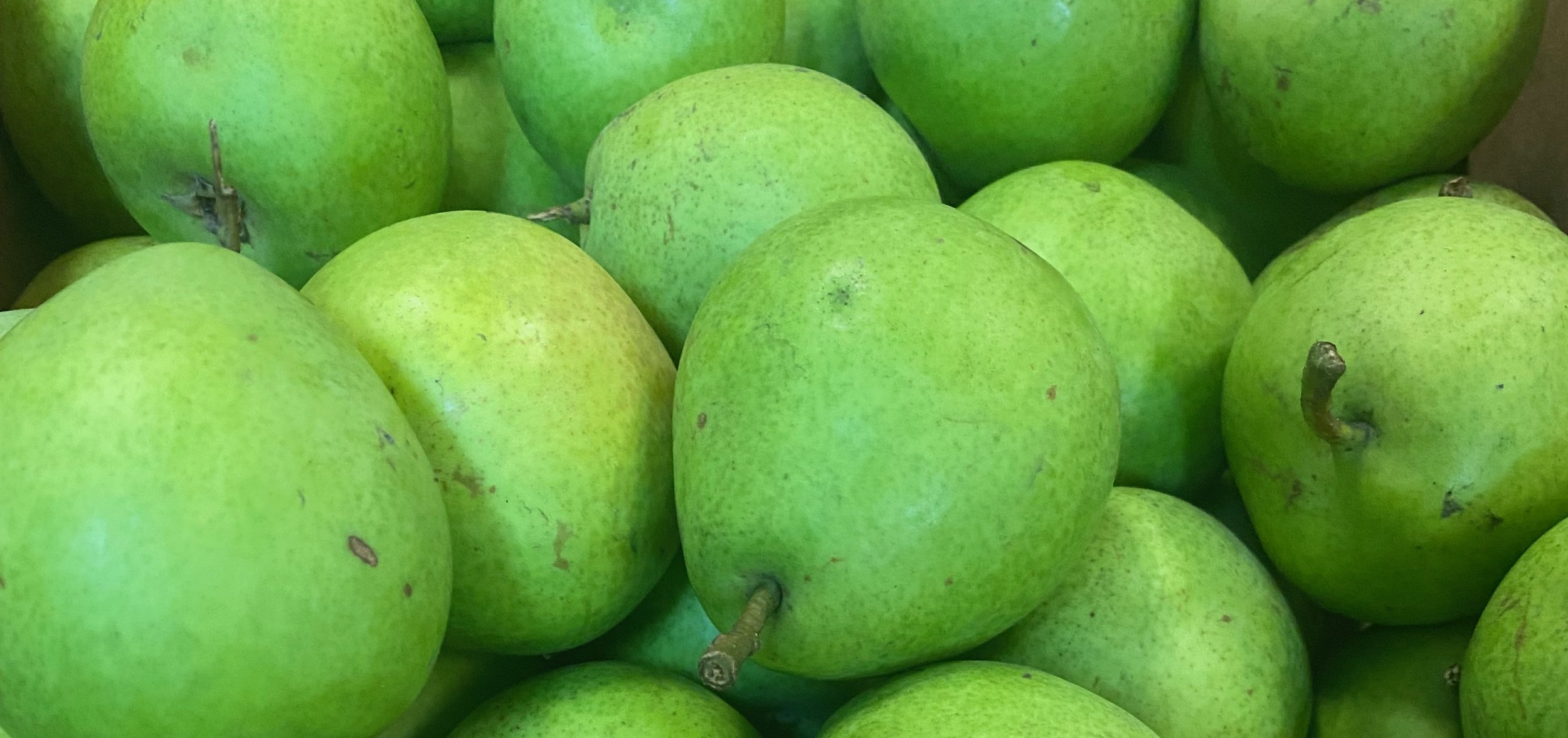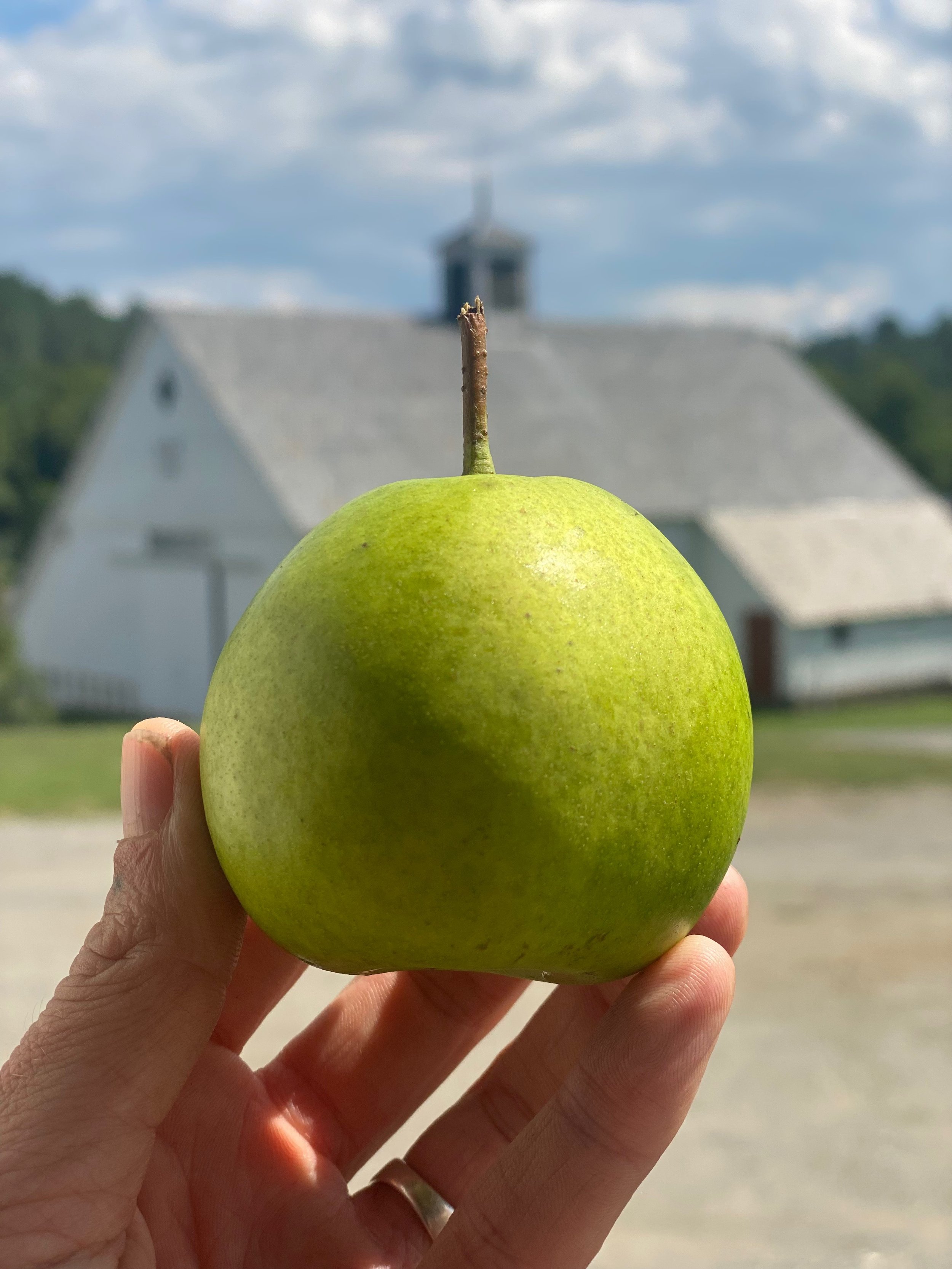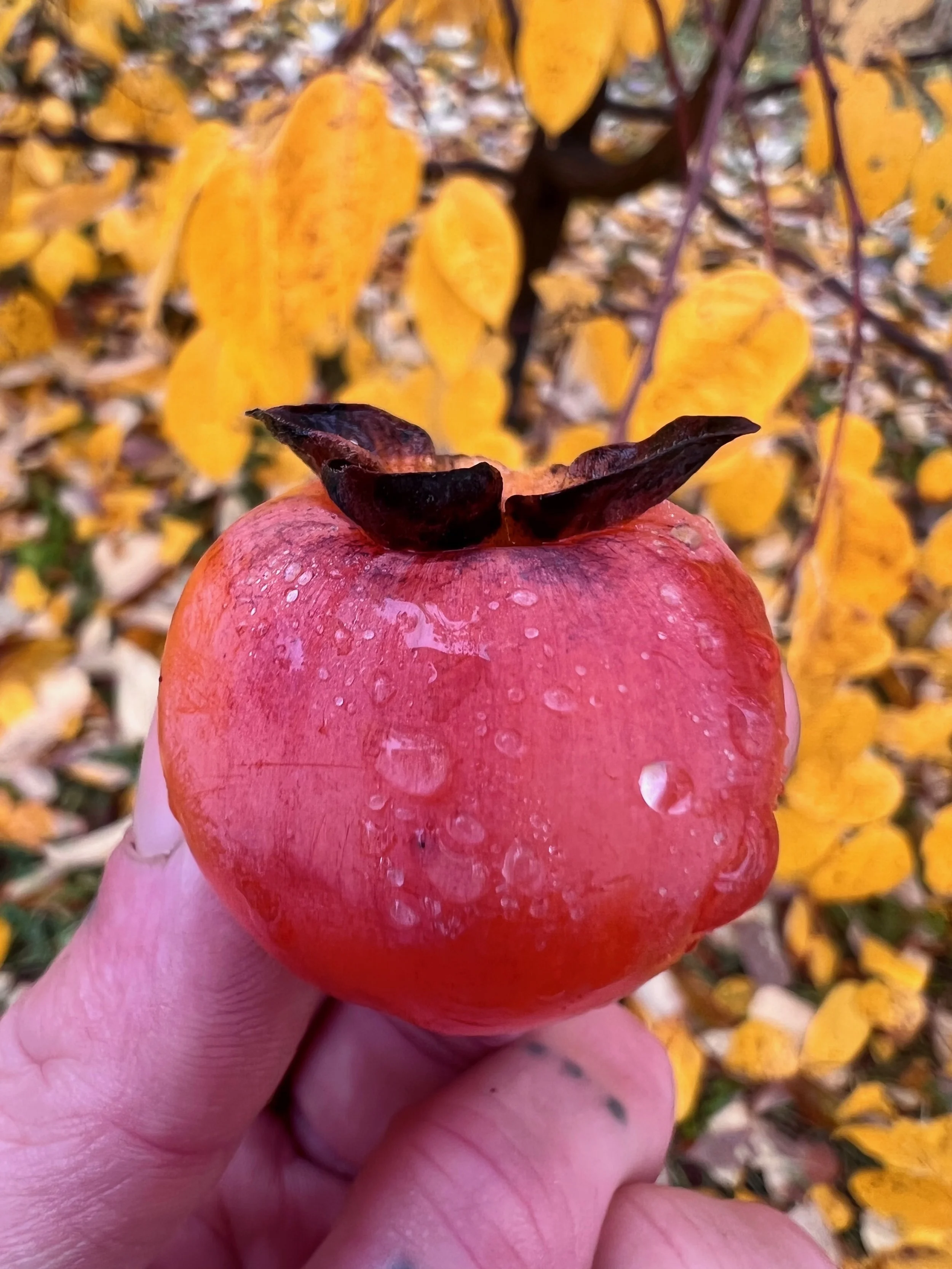
Fruit
Driven by curiosity, passion, and gourmandise, we grow many other delicious fruits along with our 130 varieties of heirloom apples.
Some fruits grown at Scott Farm, such as plums, cherries, grapes, peaches, or pears, are widely grown in the Northeast; other fruits like paw paws, quince, persimmons, or medlars are more unusual.
Availability of these fruits varies from season to season, so if you have questions or would like something shipped, give us a call at 802-254-6868 or email us at erin@scottfarmvermont.com.
Pears
We grow many varieties of pears alongside our multitude of heirloom apples. Jules Janick describes the pear perfectly in his interesting paper regarding the history of the pear for Purdue University:
As the opera lover yearns to witness, but seldom, if ever, experiences the ultimate synthesis of music and drama, so the pear connoisseur strives to obtain, but seldom gets to consume, the perfect fruit at its optimum state of maturity and stage of ripeness, to produce the perfect proportion of texture, flavor, acidity, and sweetness.
As we learn more about growing pears, we hope to offer this synthesis in every pear we grow. We grow several varieties of pear, including Bosc, Clapp’s Favorite, Red Clapp’s, Comtesse Clara Frijs, Magness, and Seckel. We also grow the Asian pear varieties Atago and Olympic.
Plums
We grow many varieties of plums that begin to come into season in August. Methley, Ousi Wase, and Early Golden are generally the earliest. Next is Shiro (pictured) which comes in mid season. Later season varieties include the royal purple Italian and Sweet Italian, the delightful Green Gage, tart Damson, and Elephant Heart. Mid and late season varieties available at our farm market; early season varieties found at local food retailers.
Peaches
We have four varieties of peaches that we grow at the farm. The earliest to come in is Garnet Beauty, a yellow flesh freestone that is medium to large. Next you’ll see Red Haven (pictured) and Starfire, which are also freestones with yellow flesh. They are large with considerable red skin. Finally, in our PYO orchard you’ll be able to enjoy picking Contender, a freestone yellow flesh variety that ripens just before Labor Day. Bounty is another later season variety, and our latest ripening variety is Blood Peach.
Blueberries
Yep, we got a few of ‘em. Start looking for blues in July at retailers like the Brattleboro Food Co-op. We do not offer PYO at this time.
Ginger
These mysterious crustacean like masterpieces will boost your antioxidants and taste buds, spice and flavor, soothe and relieve. This unassuming herbaceous perennial (dating back to Confucious!) quietly and gently creates folky medicinal magic under the soil. Testing our patience and trust, we never quite know what is taking place until the final reveal when their blushing adventitious forms are unearthed. In our eighth year growing our organically certified ginger, we never tire of the excitement and awe when the crop shows its true forms. Best known for adding its zing and punch to our heirloom cider, we also sell these beauties fresh in their true forms in our market, and to a select few local co-ops.
Available late September through October.
Medlars
Medlars are native to the Middle East and have been cultivated for thousands of years. William Shakespeare writes about this fruit that was once quite common in England in his classic love story of Romeo and Juliet. They appear as a sort of cross between apples and rose hips. You would not eat them fresh off the tree due to their tough exterior. Rather, medlars must be stored in a cool dry place until soft and edible, a process known as bletting. The consistency of the pulp is reminiscent of a baked sweet potato with a taste similar to spiced applesauce. We recommend using the pulp for jelly, or roast the fruit with cloves and butter then strain as an accompaniment to wild game. They are also fermented to make a sherry-like wine.
We were fortunate to host British medlar expert Jane Steward at Scott Farm in September 2023 for a talk on medlars. Her book, Medlars: Growing and Cooking, will tell you everything you need to know about this unique and storied fruit and is available at our Farm Store. We are also the exclusive U.S. carrier for her delicious Eastgate Larder medlar jam and chutneys.
Available Mid-October until November. Available for shipping or in the farm market. Purchase online here.
Cherries
We grow sweet cherries, which are excellent in pie with coffee. Varieties include Sandra Rose, Kristen, and Lapin. From cheesecake to chutneys to salads, this multifaceted fruit can add joy to many a delicious dish.
Grapes
We have two varieties of grapes - Concord and what we call Canadise. Canadise is more of a traditional table grape, being smaller than Concord. Both varieties will have seeds.
Currants
We grow red currants - a Victorian favorite for use in compotes and jellies. You’ll be able to find currants in our local retail locations like the Brattleboro Food Co-op in July.
Paw Paws
Though not widely known, the paw paw (or Indiana banana) is one of North America’s only native fruits. Paw paw grows naturally in southern Appalachia and throughout most of the eastern and midwestern United States. The fruit is typically 3-6 inches long with very thin, easily bruised skin. It starts green with black spots, but as it ripens in through the late summer and fall they turn yellow to brown to a purplish black color. One can smell a distinct floral and fruity scent which hints at its wide variety of reported flavors - pineapple, mango, banana. Paw paw is rather marvelous in that it has terroir - every tree and region seems to beget its own flavor.
The flesh is creamy and the seeds can be toxic, so avoid them as you enjoy the fruit. Paw paws can also have a thin layer of phenolic compounds over the meat of the fruit which should be scraped off to avoid a bitter flavor. Some folks have reported feeling nauseated after eating a paw paw fruit, so it might be wise to start with just a little taste.
Fun fact! Paw paw is pollinated by carrion flies, so their spring blooming flowers mimic the smell of rotting flesh. The flowers themselves are rather complex and resemble orchids, so despite the smell, they’re worth getting close to see.
Ripens October. Available in our farm market.
Try them as a popsicle!
Persimmons
Of Asiatic origin, records show the persimmon was grown in China 2,000 years ago. Today, it is the national fruit of Japan. While the fruit (technically a berry) traces back to China, Nepal, Korea, and Japan, it grows in temperate climates across the world and can now be found commercially available in the United States. Persimmons must be fully ripened and soft before you can enjoy their juicy, sweet flavor. They are high in tannins and are divided into astringent and non-astringent varieties. Astringent varieties should be enjoyed when they are fully ripe and very soft with a consistency akin to a very ripe tomato. Non-astringent varieties still have tannins, but can be enjoyed while still a little bit firm to the touch.
Harvest season is September through November. Available in our farm market and for shipping.
Check out this Kale Salad featuring Fuyu persimmons at Shockingly Delicious.
We also have a few more wonderful fruits in very limited quantities.
Quince
Quinces are native to Persia, now modern day Iran, and have been cultivated for more than 4,000 years. The scent of quince is unmistakable and its exquisite perfume fills a whole room if left out on a table. Quince is inedible raw and requires cooking to bring out its hidden sweet properties and rosy hue. Quince paste, so thick you can cut it with a knife, is a traditional food of the Mediterranean. The Portuguese call it marmalade, the Spanish membrillo, and in Sicily they make cotognata. We like baking slices of quince with chicken, pork, or lamb.
Quince is in season mid-October until the end of November. Available for shipping or in the farm market.
Check out this recipe for Cotognata, which is akin to a cranberry sauce and fabulous with cheese and cured meats. Or try this easy spiced Quince Preserve, a simple recipe for getting the basic idea of how to cook with quince; it might also be delicious with pork loin and Chianti.
We are not able to take pre-orders for quinces.
Apricots
A labor of love. Currently our yields are rather low due to the finicky New England spring, but we’re happy to have our few trees and look forward to adding apricots as a more consistent part of our portfolio.
Gooseberries
Like currants, there are two color distinctions of gooseberries, red and green. We grow cultivars of both. Gooseberries are positively one of the most underappreciated and overlooked berries. Harvest isn’t easy due to long thorns on the stems; but the tart sweetness within a single berry makes it all worthwhile. You’ll find our gooseberries at local retailers in July.














